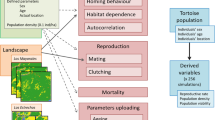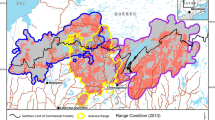Abstract
The populations of Capercaillie (Tetrao urogallus), the largest European grouse, have seriously declined during the last century over most of their distribution in western and central Europe. In the Jura mountains, the relict population is now isolated and critically endangered (about 500 breeding adults). We developed a simulation software (TetrasPool) that accounts for age and spatial structure as well as stochastic processes, to perform a viability analysis and explore management scenarios for this population, capitalizing on a 24 years-long series of field data. Simulations predict a marked decline and a significant extinction risk over the next century, largely due to environmental and demographic stochasticity (average values of life-history parameters would otherwise allow stability). Variances among scenarios mainly stem from uncertainties about the shape and intensity of density dependence. Uncertainty analyses suggest to focus conservation efforts on enhancing, not only adult survival (as often advocated for long-lived species), but also recruitment. The juvenile stage matters when local populations undergo extinctions, because it ensures connectivity and recolonization. Besides limiting human perturbations, a silvicultural strategy aimed at opening forest structure should improve the quality and surface of available patches, independent of their size and localization. Such measures are to be taken urgently, if the population is to be saved.
Similar content being viewed by others
References
H.R. Akçakaya J.L. Altwood (1997) ArticleTitleA habitat-based metapopulation model of the California Gnatcatcher Conserv. Biol. 11 422–434 Occurrence Handle10.1046/j.1523-1739.1997.96164.x
H.R. Akçakaya B. Baur (1996) ArticleTitleEffects of population subdivision and catastrophes on the persistence of a land snail metapopulation Oecologia 105 475–483 Occurrence Handle10.1007/BF00330010
P. Angelstam (1986) ArticleTitlePredation on ground nesting birds’ nest in relation to predator densities and habitat edge Oikos 47 365–373 Occurrence Handle10.2307/3565450
M. Blair R. Bijlsma W. Hagemeijer (1997) The EBCC Atlas of European Breeding Birds T. & A.D. Poyser London
C. Both (1988) ArticleTitleExperimental evidence for density dependence of reproduction in great tit J. Anim. Ecol. 67 667–774 Occurrence Handle10.1046/j.1365-2656.1998.00228.x
M.A. Burgman S. Ferson H.R. Akçakaya (1993) Risk Assessment in Conservation Biology Chapman & Hall London
J. Bustamante (1996) ArticleTitlePopulation viability analysis of captive and released Beared Vulture populations Conserv. Biol. 10 822–831 Occurrence Handle10.1046/j.1523-1739.1996.10030822.x
I.M. Cattadori S. Merler P.J. Hudson (2000) ArticleTitleSearching for mechanisms of synchrony in spatially structured gamebird populations J. Anim. Ecol. 69 620–638 Occurrence Handle10.1046/j.1365-2656.2000.00421.x
D.T. Crouse L.B. Crowder H. Caswell (1987) ArticleTitleA stage-based population model for loggerhead sea turtles and implications for conservation Ecology 68 1412–1423 Occurrence Handle10.2307/1939225
Dändliker G., Durand P., Naceur N. and Neet C. 1993. Contribution à l’étude et à la protection des grands tétras du Jura vaudois. In: Société vaudoise des Sciences naturelles (ed.), Le grand tétras Tetrao urogallus: statut et conservation des populations du Jura vaudois. Société vaudoise des Sciences naturelles, Le Brassus, Suisse, pp. 175–236.
I. Gjerde P. Wegge (1989) ArticleTitleSpacing pattern, habitat use and survival of capercaillie in a fragmented winter habitat Ornis Scand. 20 219–225 Occurrence Handle10.2307/3676916
D. Gutiérrez C.D. Thomas J.L. Leon-Cortés (1999) ArticleTitleDispersal, distribution, patch network and metapopulation dynamics of the dingy skipper butterfly (Erynnis tages) Oecologia 121 506–517 Occurrence Handle10.1007/s004420050957
I. Hanski (1991) Single-species metapopulations dynamics: concepts, models and observations I. Hanski (Eds) Metapopulation Dynamics Academic Press London 17–38
I. Hanski A. Moilanen M. Gyllenberg (1996) ArticleTitleMinimum viable metapopulation size Am. Nat. 147 527–541 Occurrence Handle10.1086/285864
Höglund N. 1952. Capercaillie reproduction and climate. Pap. Game Res. 78–86.
InstitutionalAuthorNameIUCN (1996) Red List of Threatened Animals IUCN Gland, Switzerland
L. Koivisto (1963) ArticleTitleÜber den Ortwechsel der Geschlechter beim Auerhuhn nach Markierungergebnissen Volgelwarte 22 75–79
B. Leclercq (1987a) Ecologie et dynamique des populations du grand tétras (Tetrao urogallus major L.) dans le Jura français Université de Bourgogne Dijon
B. Leclercq (1987b) Influence des modes de gestion forestière passées sur la gestion actuelle et la structure des forêts de montagne ainsi que sur leurs peuplements en grand tétras Actes du Colloque Galliformes de montagne Gibier Faune Sauvage Grenoble, France 265–282
Leclercq B. 1987c. Premières données sur la comparaison de la dynamique des populations de grand tétras (Tetrao urogallus) et de gélinotte des bois (Bonasa bonasia) d’un même massif forestier du Haut-Jura. In: Actes du Colloque Galliformes de montagne. Gibier Faune Sauvage, Grenoble, France, pp. 21–36.
E. Ménoni (1991) Ecologie et dynamique des populations du grand tétras dans les Pyrénées, avec des références spéciales à la biologie de la reproduction chez les poules: quelques applications à sa conservation Université Paul Sabatier Toulouse
E. Ménoni (1994) ArticleTitlePlan de restauration du grand tétras (Tetrao urogallus) en France Gibier Faune Sauvage 11 159–202
E. Ménoni J.F. Brenot M. Catusse (1994) ArticleTitleGrand tétras et ski de fond Bull. mens. de l’ONC 190 12–21
Montadert M. and Chamouton A. 1997. Statut des tétraonidés dans le massif jurassien. In: Parc naturel régional du Haut-Jura (ed.), Secondes Rencontres Jurassiennes. Parc naturel régional du Haut-Jura, Prénovel. France, pp. 73–95.
R. Moss J. Oswald (1985) ArticleTitlePopulation dynamics of Capercaillie in a North-east Scottish glen Ornis Scand. 16 229–238 Occurrence Handle10.2307/3676635
R. Moss J. Oswald D. Baines (2001) ArticleTitleClimate change and breeding success: decline of the capercaillie in Scotland J. Anim. Ecol. 70 47–61 Occurrence Handle10.1046/j.1365-2656.2001.00473.x
R. Moss D.N. Weir (1987) ArticleTitleDemography of capercaillie Tetrao urogallus in north-east Scotland. II. Age and sex distribution Ornis Scand. 18 135–140 Occurrence Handle10.2307/3676848
N. Picozzi D.C. Catt R. Moss (1992) ArticleTitleEvaluation of capercaillie habitat J. Appl. Ecol. 29 751–762 Occurrence Handle10.2307/2404485
N. Picozzi R. Moss K. Kortland (1999) ArticleTitleDiet and survival of capercaillie Tetrao urogallus chicks in Scotland Wildlife Biol. 5 11–23
J.M. Reed D.D. Murphy P.F. Brussard (1998) ArticleTitleEfficacy of population viability analysis Wildlife Soc. Bull. 26 244–251
S. Sachot (2000) TetrasPool. Version 1.0.2 Laboratory for Conservation Biology, Institute of Ecology, University of LausanneCH-1015 Lausanne Switzerland
S. Sachot (2002) Viabiliy and Management of an Endangered Capercaillie (Tetrao urogallus) Metapopulation Faculté des sciences Université de LausanneSuisse
S. Sachot N. Perrin C. Neet (2003) ArticleTitleWinter habitat selection by two sympatric forest grouse in western Switzerland: implications for conservation Biol. conserv. 112 373–382 Occurrence Handle10.1016/S0006-3207(02)00334-8
B.-E. Saether S. Engen J.E. Swenson O. Bakke F. Sandegren (1998) ArticleTitleAssessing the viability of Scandinavian brown bearUrsus arctospopulations: the effects of uncertain parameter estimates Oikos 83 403–416 Occurrence Handle10.2307/3546856
A. Schifferli P. Géroudet R. Winkler (1980) Atlas des oiseaux nicheurs de Suisse Station ornithologique suisse Sempach
H. Schmid R. Luder B. Naef-Danzer R. Graf N. Zbinden (1998) Atlas des oiseaux nicheurs de Suisse Station ornithologique suisse Sempach
G. Segelbacher I. Storch (2002) ArticleTitleCapercaillie in the Alps: genetics evidence of metapopulation structure and population decline Mol. Ecol. 11 1669–1677 Occurrence Handle12207718 Occurrence Handle10.1046/j.1365-294X.2002.01565.x Occurrence Handle1:CAS:528:DC%2BD38XnvVWhsbw%3D
A. Sinclair (1989) Population regulation in animals J.M. Cherett (Eds) Ecol. Concepts Blackwell Scientific Publications Oxford 197–241
T. Storaas P. Wegge (1984) High nest losses in capercaillie and black grouse in Norway T.W.I. Lovel P.J. Hudson (Eds) Third International Grouse Symposium C.I.C. World Pheasants Association York 481–492
I. Storch (1991) ArticleTitleHabitat fragmentation, nest site selection, and nest predation risk in Capercaillie Ornis Scand. 22 213–217 Occurrence Handle10.2307/3676592
I. Storch (1993) Habitat use and spacing of capercaillie in relation to forest fragmentation patterns Université Ludwig-Maximilian Munich
I. Storch (1995) ArticleTitleAnnual home ranges and spacing patterns of capercaillie in central Europe J. Wildlife Manage. 59 392–400 Occurrence Handle10.2307/3808953
I. Storch (2000) Grouse Status Survey and Conservation Action Plan WPA/Birdlife/SSC Grouse Specialist Group. IUCNGlandSwitzerland and the World Pheasant Associations, Reading UK
R.W. Summer R.E. Green R. Proctor D. Dugan D. Lambie R. Moncrieff R. Moss D. Baines (2004) ArticleTitleAn experimental study of the effects of predation on the breeding productivity of capercaillie and black grouse J. Appl. Ecol. 41 513–525 Occurrence Handle10.1111/j.0021-8901.2004.00891.x
J. Trouvilliez J.M. Gaillard D. Allaine D. Pontier (1988) ArticleTitleStratégies démographiques et gestion des populations chez les oiseaux: particularités des Galliformes Gibier Faune Sauvage 5 27–41
Wegge P., Gjerde I., Kastdalen J., Rolstad J. and Storaas T. 1990. Natural mortality and predation of adult capercaillie in south-east Norway. In: Proceeding of the International Symposium on Grouse, pp. 49–56.
P. Wegge B. Larsen T. Storaas (1981) Dispersion printanière d’une population de coqs de bruyère dans le sud-est de la Norvège C. Kempf (Eds) Actes du Colloque International Grand Tétras Union Nationale des Associations Ornithologiques Colmar, France 138–153
J.M. Yearsley D. Fletcher C. Hunter (2003) ArticleTitleSensitivity analysis of equilibrium population size in a density-dependent model for Short-tailed Shearwaters Ecol. Model. 163 119–129 Occurrence Handle10.1016/S0304-3800(02)00416-7
Author information
Authors and Affiliations
Corresponding author
Rights and permissions
About this article
Cite this article
Sachot, S., Perrin, N. & Neet, C. Viability and Management of an Endangered Capercaillie (Tetrao urogallus) Metapopulation in the Jura Mountains, Western Switzerland. Biodivers Conserv 15, 2017–2032 (2006). https://doi.org/10.1007/s10531-005-0771-y
Received:
Accepted:
Published:
Issue Date:
DOI: https://doi.org/10.1007/s10531-005-0771-y




